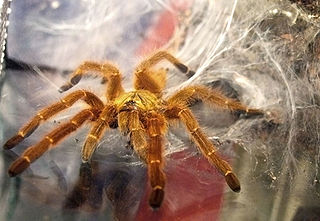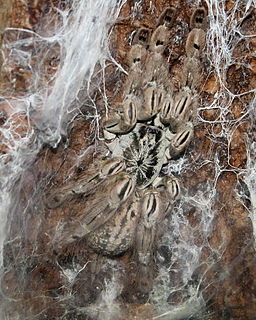
The cephalothorax, also called prosoma in some groups, is a tagma of various arthropods, comprising the head and the thorax fused together, as distinct from the abdomen behind. The word cephalothorax is derived from the Greek words for head and thorax. This fusion of the head and thorax is seen in chelicerates and crustaceans; in other groups, such as the Hexapoda, the head remains free of the thorax. In horseshoe crabs and many crustaceans, a hard shell called the carapace covers the cephalothorax.

The Harpactirinae are a subfamily of tarantulas which are native to the continent of Africa. Like many Old World tarantulas, they have a relatively strong venom, and can inflict a painful bite.

Pterinochilus murinus, is an old-world tarantula that was first described in 1897 by Reginald Innes Pocock. This species is found on the African continent, in Angola, as well as central, eastern, and southern Africa. It is a member of the subfamily Harpactirinae, baboon spiders.

Ceratogyrus is a genus of tarantulas found in southern Africa. They are commonly called horned baboons for the foveal horn found on the peltidium in some species. They are readily distinguished from other African theraphosid genera by the combined presence of a retrolateral cheliceral scopula, composed of plumose, stridulatory setae, and the strongly procurved fovea. The fovea is typically strongly procurved and in some species surrounds a distinct protuberance. this protuberance may take the form of a simple posterior extension of the caput, a low-set plug or a prominent, discrete conical projection. All Ceratogyrus species possess a pale yellow anteriorly placed, transverse, sub-abdominal band. This feature is not distinct in other Harpatirinae except Augacephalus junodi. The absence of dense, ventral femoral fringes on the palpi and legs I and II distinguish Ceratogyrus spp. from female A. junodi.

Ceratogyrus darlingi is a theraphosid spider from southern Africa, mainly Botswana and Lesotho. They reach a body length of about 5 inches (130 mm) and are ash-gray, mud-brown to black. The peltidium features a black foveal horn.
Ceratogyrus brachycephalus is an old world terrestrial tarantula that grows to a legspan of up to 5 inches (12 cm). The common name comes from the "horn", or protuberance, on the carapace.

The southern woolly lemur, or southern avahi, has been recently recognized as a separate species of woolly lemur in 2006 by Zaramody et al. It is a nocturnal and pair-living species. Groups can range from 2 to 5 individuals. A study in Sainte Luce forest revealed home range varied from 2.2 to 3.5 ha and that males can have larger home range and cover longer daily distances than females, in agreement with the territory defence and mate guarding hypotheses.
Hysterocrates gigas is a member of the tarantula family, Theraphosidae found in Cameroon. It is known as the giant baboon spider, Cameroon red baboon spider, or red baboon tarantula.

The king baboon spider, scientific name Pelinobius muticus, is a tarantula species native to East Africa. It is the only species in the genus Pelinobius. The king baboon spider can grow up to 20 cm in leg span. It is a slow-growing species. The spider is often rusty brown or orange in colour. As a burrowing species, the back legs are very thick and used for digging burrows. It is popular among tarantula collectors but is highly defensive and not suitable for beginners. They also have very strong venom ; a bite from a baby of this species caused sharp pain and the place of the bite remained itchy for five days.
Pterinochilus chordatus, or Kilimanjaro mustard baboon spider, is an old-world tarantula, first described in 1873 by Carl Eduard Adolph Gerstaecker. This species is found on the East side of the African continent, from South Kordofan in Sudan in the north, to Tanzania in the south. It has a body length of up to 2 inches (5 cm) and a leg span of up to 6 inches (15 cm).

Heteroscodra maculata is an Old World species of tarantula which was first described in 1899 by Reginald Innes Pocock. This species native to West Africa and is found primarily in Togo and Ghana. This species has many common names, of which Togo starburst and ornamental baboon are most frequently encountered.
The Selenogyrinae are a subfamily of tarantulas found in Africa and Asia.
Euphrictus is a genus of tarantula which is found in Africa. It is part of the subfamily Selenogyrinae.
Selenogyrus aureus is a species of tarantula, in the subfamily Selenogyrinae. It is endemic Sierra Leone.
Selenogyrus africanus is a species of tarantula, which is native to the Ivory Coast and is a member of the Selenogyrinae subfamily.
Selenogyrus brunneus is a species of tarantula, found in West Africa.
Selenogyrus caeruleus is a species of tarantula native to Sierra Leone.

Ceratogyrus dolichocephalus is a species of tarantula. It is endemic to Zimbabwe.












